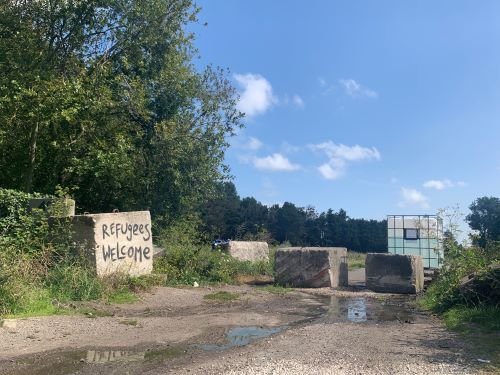Policing Water: France’s dangerous deterrence methods harm refugees
Creating a hostile environment
Seeking asylum is a universal human right. But for years, European countries have pursued harsh policies designed to deter people from exercising this right.
Location of a CFC water tank, and the same site with police parked in front of the tank. At the time these photos were taken, at least two families with children were living at the site.
Governments refuse the duty of search and rescue along dangerous sea routes. Detention of asylum seekers is common practice, often for long periods and in poor conditions. And people on the move face police aggression and constant pushbacks— measures to force refugees back across borders to avoid responsibility for their asylum claims.
The French state’s message is clear: Refugees and asylum seekers are unwanted and unwelcome.
In Calais, the city centre can be a lifeline for refugees. Local NGOs distribute hot meals, clothing, SIM cards, and other material aid within blocks of the train station. Public toilets and drinking water sources, of which there are few, are also nearby.
For refugees and the NGOs supporting them, such accessibility comes at a cost.
Local authorities target downtown living sites for evictions and surveillance. This drives refugees to camp further from the city centre, and thus further from essential aid and services.
As camps become more remote and spread out, aid organisations face heightened operational challenges. Refugees new to Calais are especially more difficult to find and connect to the local NGOs who meet their basic needs.
“Many people have to walk long distances for water. The police are always evicting and stealing tents. People move further away from the city centre,” said Sami, a Sudanese refugee in his 30s. “Calais is a place that can make you feel stuck.”
Police drained hundreds of litres of drinking water before confiscating the water tank.
Denial of water
In Calais, restricted water access is both a deterrent unto itself and a factor that compounds the effects of other deterrents used by the French state.
Often, deterrence can look as simple as police presence at water sources. Police regularly patrol the areas around Collective Aid’s WASH centre. CA staff have also observed officers lingering at water tanks maintained by Calais Food Collective (CFC), a close partner of CA.
Police at the water site
Each day, CFC cleans and fills 1,000 litre tanks of water in some living sites and central locations in Calais. Because the French government fails to provide adequate water access to refugees, these tanks are crucial for meeting drinking, cooking, and hygiene needs.
One CFC tank was located just blocks behind Calais city hall. But on August 11, CA staff witnessed municipal authorities confiscating the tank. CFC volunteers asked if they could take the tank away in their own van, but the request was denied by the police.
Calais’s deputy mayor, Philippe Mignonet, oversaw the removal. Volunteers questioned him on how refugees should access drinking water without the city centre tank. He suggested that CFC hand out water bottles— an absurdly inadequate response to the needs of the city’s refugees.
People on the move in Calais already survive on volumes of water well below the minimum daily recommendation. The World Health Organisation estimates daily water needs per person to be 50 to 100 litres. In contrast, Coalition Eau and Solidarities International found that refugees in Calais had access to an average of 4.9 litres per day. This is a far cry from the 150 litres used by the average Calaisian citizen.
“We are human beings… Of course we need more water,” Farid, an asylum seeker from Afghanistan, said. “But we come to this country, we don’t have a place to live, and they say ‘It’s not your house, you don’t have papers…’ So what can you do?”
Use of tear gas
Lack of water access also exacerbates the effects of police violence. Tear gas is a particularly potent threat. French police have been recorded using tear gas to prevent asylum seekers from boarding boats. During evictions of camps, police regularly threaten to use rubber bullets and tear gas. In many cases, they are actually deployed.
Tear gas reacts to sweat and oils on the skin to produce a burning feeling that blurs vision and makes breathing difficult. According to public health experts, access to clean water is imperative after exposure. A person’s eyes must be rinsed thoroughly to avoid infection. Likewise, washing gas residue off one’s skin and clothes prevents further irritation. Without an aerosolizing solvent, tear gas’s powder form sticks particularly well to clothing fibres and hair.
Access to enough clean water to treat tear gas exposure is a rarity in Calais. Evictions usually take place early in the morning, well before water tanks are refilled or community centres open.
Coming to Collective Aid’s WASH, a community space and laundry centre, is one of the only ways refugees can clean their clothes. Working at the WASH, CA Volunteers have detected residual tear gas on people’s clothing.
To prevent the spread of scabies and other common diseases found in the camps, clothes are washed at 60 degrees. The high heat and humidity during washing, however, reactivates tear gas residue. Volunteers have reported feeling irritation in their eyes and throats when handling clothes fresh from the washing and drying cycles.
France can choose to provide enough water to its most vulnerable populations and stop undermining organisations that provide the services that the state should.
Cruelty through the failure to fulfil basic needs is not an effective or legal deterrent for people exercising the universal right to seek asylum. To join our campaign to ensure #WaterForAll, sign the petition today.



